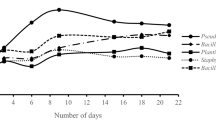Abstract
A new strain of bacterium degrading polyaromatic hydrocarbons (PAHs), Burkholderia cepacia 2A-12, was isolated from oil-contaminated soil. Of three PAHs, the isolated strain could utilize naphthalene (Nap) and phenanthrene (Phe) as a sole carbon source but not pyrene (Pyr). However, the strain could degrade Pyr when a cosubstrate such as yeast extract (YE) was supplemented. The PAH degradation rate of the strain was enhanced by the addition of other organic materials such as YE, peptone, glucose, and sucrose. YE was a particularly effective additive in stimulating cell growth as well as PAH degradation. When 1 g YE l−1, an optimum concentration, was supplemented into the basal salt medium (BSM) with 215 mg Phe l−1, the specific growth rate (0.30 h−1) and Phe-degrading rate (29.6 μmol l−1 h−1) were enhanced approximately ten and three times more than those obtained in the BSM with 215 mg Phe l−1, respectively. Both cell growth and PAH degradation rates were increased with increasing Phe and Pyr concentrations, and B. cepacia 2A-12 had a tolerance against Phe and Pyr toxicity at the high concentration of 730–760 mg l−1. Through kinetic analysis, the maximum specific growth rate (μ max) and PAH degrading rate (ν max) for Phe were obtained as 0.39 h−1 and 300 μmol l−1 h−1, respectively. Also, μ max and ν max for Pyr were 0.27 h−1 and 52 μmol l−1 h−1, respectively. B. cepacia 2A-12 could simultaneously degrade crude oil as well as PAHs, indicating that this bacterium is very useful for the removal of oils and PAHs contaminants.
Similar content being viewed by others
References
Ahn, I.S., Ghiorse, W.C., Lion, L.W. & Shuler, M.L. 1998 Growth kinetics of Pseudomonas putida G7 on naphthalene and occurrence of naphthalene toxicity during nutrient deprivation. Biotechnology and Bioengineering 59, 587–594.
Barclay, C.D., Farqubar, G.F. & Legge, R.L. 1995 Biodegradation and sorption of polyaromatic hydrocarbons by Phaenerochaete chrysosporium. Applied Microbiology and Biotechnology 42, 958–963.
Bauer, J.E. & Capone, D.G. 1988 Effects of co-occurring aromatic hydrocarbons on degradation of individual polycyclic aromatic hydrocarbons in marine sediment slurries. Applied and Environmental Microbiology 54, 1649–1655.
Bezalel, L., Hadar, Y., Fu, P.P., Freeman, J.P. & Cerniglia, C.E. 1996 Initial oxidation products in the metabolism of pyrene, anthracene, fluorine, and dibenzothiophene by the white rot fungus Pleurotus ostreatus. Applied and Environmental Microbiology 62, 2554–2559.
Boonchan, S., Briz, M.L. & Stanley, G.A. 1998 Surfactant-enhanced biodegradation of high molecular weight polycyclic aromatic hydrocarbons by Stenotrophomonas maltophilia. Biotechnology & Bioengineering 59, 482–494.
Boonchan, S., Britz, M.L. & Stanley, G.A. 2000 Degradation and mineralization of high-molecular-weight polycyclic aromatic hydrocarbons by defined fungal-bacterial cocultures. Applied and Environmental Microbiology 66, 1007–1019.
Bossert, I.D. & Bartha, R. 1986 Structure-biodegradability relationships of polycyclic aromatic hydrocarbons in soil. Bulletin of Environmental Contamination and Toxicology 37, 490–495.
Canet, R., Brinstingl, J.G., Malchlm, D.G., Lopez-Real, J.M. & Beck, A.J. 2001 Biodegradation of polycyclic aromatic hydrocarbons (PAHs) by native microflora and combinations of white-rot fungi in a coal-tar contaminated soil. Bioresource Technology 76, 113–117.
Chen, S.H. & Aitken, M.D. 1999 Salicylate stimulates the degradation of high-molecular weight polycyclic aromatic hydrocarbons by Pseudomonas saccharophila P15. Environmental Science and Technology 33, 435–439.
Collins, P.J., Kotterman, J.J., Field, J.A. & Dobson, A.D.W. 1996 Oxidation of anthracene and benzo[a]pyrene by laccases from Trametes versicolor. Applied and Environmental Microbiology 62, 4563–4567.
Geiselbrecht, A.D., Hedlund, B.P., Tichi, M.A. & Staley, J.T. 1998 Isolation of marine polycyclic aromatic hydrocarbon (PAH)-degrading Cycloclasticus strains from gulf of Mexico and comparison of their PAH degradation ability with tat of Puget sound Cycloclasticus strains. Applied and Environmental Microbiology 64, 4703–4710.
Hedlund, B.P., Geiselbrecht, A.D., Bair, T.J. & Staley, J.T. 1999 Polycyclic aromatic hydrocarbon degradation by a new marine bacterium, Neptunomonas naphthovorans gen. nov., sp. nov. Applied and Environmental Microbiology 65, 251–259.
Heitkamp, M.A., Freeman, J.P., Miller, D.W. & Cerniglia, C.E. 1988 Pyrene-degradation by a Mycobacterium sp.: identification of oxidation and ring fission products. Applied and Environmental Microbiology 54, 2556–2565.
Ho, Y., Jackson, M., Yang, Y., Mueller, J.G. & Pritchard, P.H. 2000 Characterization of fluoranthene-and pyrene-degrading bacteria isolated form PAH-contaminated soils and sediments. Journal of Industrial Microbiology and Biotechnology 24, 100–112.
Juhasz, A.L., Britz, M.L. & Stanley, G.A. 1997 Degradation of fluoranthene, pyrene, benz[a]anthracene and dibenz[a,h]anthracene by Burkholderia cepacia. Journal of Applied Microbiology 83, 189–198.
Kästner, M., Breuer-Jammli, M. & Mahro, B. 1994 Enumeration and characterization of the soil microflora from hydrocarbon-contaminated soil sites able to mineralize polycyclic aromatic hydrocarbons (PAH). Applied Microbiology and Biotechnology 41, 267–273.
Kästner, M. & Mahro, B. 1996 Microbial degradation of polycyclic aromatic hydrocarbons in soils affected by the organic matrix of compost. Applied Microbiology and Biotechnology 44, 668–675.
Lethomaki, M. & Niemela, S. 1975 Improving microbial degradation of oil in soil. Ambio 4, 126–129.
Sutherland, J.B. 1992 Detoxification of polycyclic aromatic hydrocarbons by fungi. Journal of Industrial Microbiology 62, 13–19.
Vogel, T.M. 1996 Bioaugmentation as a soil bioremediation approach. Current Opinion in Biotechnology 7, 311–316.
Walter, U., Beyer, M., Klein, J. & Rehm, H.J. 1991 Degradation of pyrene by Rhodococcus sp. UW1. Applied Microbiology and Biotechnology 34, 671–676.
Walton, B.T. & Anderson, T.A. 1988 Structural properties of organic chemicals as predictors of biodegradation and microbial toxicity in soil. Chemosphere 17, 1501–1507.
Weissenfels, W.D., Beyer, M. & Klein, J. 1990 Degradation of fluoranthene by pure bacterial cultures. Applied Microbiology and Biotechnology 32, 479–484.
Wilson, S.C. & Jones, K.C. 1993 Bioremediation of soils contaminated with polynuclear aromatic hydrocarbons (PAHs). Environmental Pollution 88, 229–249.
Ye, D., Siddiqi, M.A., Maccubbin, A.E., Kumar, S. & Sikka, H.C. 1996 Degradation of polynuclear aromatic hydrocarbons by Sphingomonas paucimobilis. Environmental Science and Technology 30, 136–142.
Yuan, S.Y., Wei, S.H. & Chang, B.V. 2000 Biodegradation of polycyclic aromatic hydrocarbons by a mixed culture. Chemosphere 41, 1463–1468.
Author information
Authors and Affiliations
Rights and permissions
About this article
Cite this article
Kim, T.J., Lee, E.Y., Kim, Y.J. et al. Degradation of polyaromatic hydrocarbons by Burkholderia cepacia 2A-12. World Journal of Microbiology and Biotechnology 19, 411–417 (2003). https://doi.org/10.1023/A:1023998719787
Published:
Issue Date:
DOI: https://doi.org/10.1023/A:1023998719787




